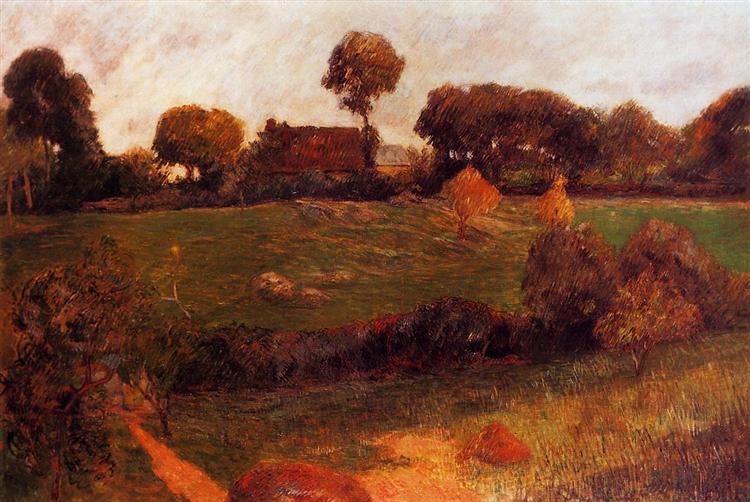Description
Paul Gauguin's Farmhouse in Brittany, painted in 1886, exemplifies a pivotal stage in the artist's evolution toward a painting style that challenges the conventions of academic art of his time. This painting is especially significant because it reflects a moment when Gauguin was beginning to explore the synthesis of color and form, as well as an idealization of rural life that contrasted with the realities of industrialized modernity.
In the composition of "Farm in Brittany", a well-defined structure is observed, where simplified geometric shapes are aligned, outlining both the architecture of the barn and the surrounding landscape. The horizontal lines that make up the facade of the building and the land intertwine with the verticality of the trees, creating a visual tension that invites the viewer to explore the painting in search of a richer narrative than the superficial presentation of a rural landscape.
The use of colour in this work is particularly notable. Gauguin uses a palette that departs from natural and realistic tones, elevating saturated yellow, green and brown to an almost symbolic level. The earthy-hued land seems to vibrate, while the sky, in a deep blue, finds its counterpoint in the intensity of the surrounding colours. This choice of colour is not only a characteristic of post-impressionism, of which Gauguin is one of the greatest exponents, but also suggests an intention to evoke emotional states, transcending the mere portrait of the landscape to build an atmosphere charged with meaning.
In the foreground of the painting, figures can be glimpsed that, although not fully developed, suggest the presence of peasants. These figures, with their simple posture and clothing, seem to be in harmony with the land around them, symbolizing a deep connection between humanity and its environment. Although Gauguin does not present a clear narrative narration, these characters contribute to the overall atmosphere of the work, creating a sense of rural life that contrasts with the social dynamics of contemporary Paris.
The painting's background, adorned with lush vegetation and an expanded sky, complements the visual legacy of symbolism and the use of nature as a means of expressing emotional interiority. This aspect of "Farm in Brittany" reflects Gauguin's search for deeper meaning in the simplicity of everyday life, anticipating his later dream of escaping to Tahiti, seeking a primitive and authentic paradise.
It is interesting to note that "Farm in Brittany" was created at a time when Gauguin was distancing himself from Impressionist traditions, feeling the need to find forms of expression that were more internal and personal. The work encapsulates a sense of nostalgia for and at the same time idealization of rural life, a recurring theme in his work that later gained further strength in his contemporary explorations of exoticism.
In conclusion, Farm in Brittany is not just a landscape; it is a visual essay that encapsulates Gauguin's quest for an art that transcends mere representation to engage the viewer in a dialogue with nature, rural life, and human emotions. The work stands out within the canon of post-impressionism, serving as a precursor to contemporary expressions in art that prioritize viscerality, emotive colorimetry, and the intrinsic connection between the human being and his or her environment.
KUADROS ©, a famous painting on your wall.
Hand-made oil painting reproductions, with the quality of professional artists and the distinctive seal of KUADROS ©.
Painting reproduction service with satisfaction guarantee. If you are not completely satisfied with the replica of your painting, we will refund 100% of your money.

